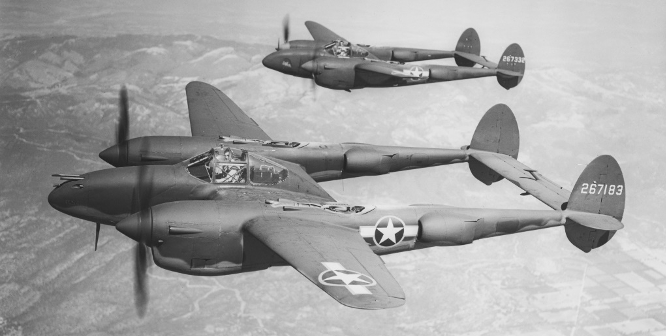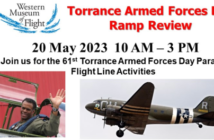My father, Seymour Liebman was a career Air Force Officer and Command Pilot who finished with over 5,000 hours in 25 different airplanes. Following is a story he told me one afternoon over a beer when we were talking about flying.
The story begins when he went through the training command in 1940. The hottest airplane coming into the U.S. Army Air Corps was the twin engine P-38. Design work on the twin-engine fighter began in 1937 three years before North American responded to an RAF enquiry in 1940 that ultimately resulted in the P-51 and four years before the P-47 first flew.
The Army Air Corps specification required the airplane to be capable of 360 miles an hour at 20,000 feet and could cruise at full throttle at that altitude for at least an hour. The specs also required that the plane take off at maximum takeoff weight and clear a 50-foot obstacle in 2,200 feet.
Given the state of aviation technology at the time, it was a tall order. The plane’s designer Howard L. Hibbard concluded that in 1937 no engine, either on the drawing board or in production, could power an airplane that could meet the Air Corps specification. His unique design housed the engines in two booms connected by a high aspect ratio wing and the horizontal elevator. In the booms, he had room for the turbochargers for each engine leaving the wing for fuel. In the center of the wing, a pod housed the pilot and one 20-millimeter cannon and four, 50-caliber machine guns.
The contract for the first prototype was issued in June 1937 and the first flight was on January 27th, 1939. Two weeks later, the prototype flew from March Field in California to Mitchell Field in New York in seven hours and two minutes, not including time for two fuel stops. Lockheed received an order for 13 prototypes with counter rotating propellers to offset the torque which was quickly followed by a production order for 60 airplanes in September 1939.
Meanwhile, my father Sy was a college student until he started flight Air Corps flight training in February 1940. Delays in the production and development of the P-38 caused the Air Corps to send pilots who were supposed to go to P-38 squadrons and trained to fly twin engine airplanes to fly the A-20 Havoc, B-25 Mitchell or B-26 Marauder. Others went to transport squadrons to fly the C-47.
Sy wasn’t one of the lucky few and was sent to the 34th Bomb Squadron. He arrived just before its pilots and crews along with its B-25s came on board the U.S.S. Hornet in 1942. This would be known as the Doolittle raid. In pictures of the Doolittle raiders wearing their leather flight jackets, the 34th’s Thunderbird patch is clearly visible.
In the spring, of 1943 the 34th Bomb Squadron was based at Telerghma, Algeria. It was also accompanied by a P-38 fighter group. Sy happened to know one of the pilots and was able to obtain permission to fly one of the P-38s.
After studying the pilot operating manual, being quizzed on the airplane’s systems and given a blindfold cockpit check, my father taxied out to the runway in the airplane of his dreams, a P-38F. Back in those days, one didn’t go to ground school, sit in a cockpit procedures trainer, and fly a simulator for hours on end before one was trusted to fly a real airplane. What he went through was the “norm.”
In his logbooks, my father’s first flight of a half dozen in a P-38 in North Africa is listed as a “liaison” flight. Listening to him talk about them, I’d classify them as joy rides. When he pushed the throttles forward to takeoff, he was in a fully fueled, P-38F with a full load of ammunition. His only restriction was that he was not to go “hunting” for German or Italian aircraft. However, if Telerghma was raided by the Luftwaffe, he was free to help defend the airfield.
Unlike many fighters of the era, the P-38 had a wheel instead of a stick. On a quadrant attached to the left wall of the cockpit, the throttle, mixture and propeller controls were just ahead of the trim wheels which were in front of the armament switches. On the right, were the radio controls and the knobs and switches for the oxygen. The cockpit heater was in a small console between one’s legs. The instruments for both flying and the engines were right in front of the pilot along with the instrument panel. To a pilot familiar with modern cockpits, the flight instruments such as – airspeed, altimeter, attitude gyro, vertical speed indicator, gyro compass – instruments were not in the classic T pattern, but were grouped together. The hydraulic system and fuel quantity gauges were on the lower left of the panel while the engine and electrical system instruments took up most of the right side.
What caught my father by surprise was how fast the P-38 accelerated down the runway. Unlike the B-26 that took several thousand feet to get to takeoff speed, the P-38 left the ground in about a thousand feet or so. According to him, at full power, it climbed like a home sick angel. The F models were the first truly combat ready variants and like the medium bomber pilots, the P-38 drivers were also learning on the job. The L and J models which came later and were the ones produced in the greatest quantity had innovations to make the plane faster, more maneuverable and gave the P-38 longer range.
None of these things mattered to Sy as he headed north and out over the Mediterranean. For the next three hours, he did aerobatics, pushing the airplane deep into steep turns, loops, split S’s, aileron, barrel rolls and whatever else he could think of doing. On one practice pursuit curve and simulated gunnery run at about 15,000 feet, he pulled back on the yoke to tighten the right turn as he practiced making a 90-degree deflection shot. He felt the g’s increase and suddenly the P-38 shuddered violently and snapped over on its back, nose down in a spin. He’d inadvertently entered a high-speed stall! His head snapped to the side and he was lucky he was not knocked out. Back in those days, they wore soft leather helmets, not the protective bone domes worn today.
Talking about it 25 odd years later, my father was still animated as he described the event. He admitted he was stunned for a few seconds and when he came to his senses, the nose was below the horizon. One second, he could see the North African coastline and a second later, it was the blue of the Mediterranean.
He thought he stalled the airplane at around 15,000 feet. When he pushed the left rudder pedal and shoved yoke forward to recover from the tight spin, the altimeter was unwinding rapidly passing 8,000 feet. Sy pulled the throttles to idle and as soon as the rotation stopped, raised and centered the yoke before pulling back to pull out. As he applied throttle to climb, the altimeter read 1,900 feet. Chastised, he climbed back to about 10,000 feet and did a few more minutes of aerobatics before heading back to Telerghma. There he flew two touch-and go’s and one full stop so he was fully checked out.
Telling me about that episode, my father said that had it not been for the honest characteristics of the P-38, he would have augured into the water. Little did he know that his son would depart a T-28 in 1969 cracking his helmet, and his grandson would cartwheel a T-45 during a solo air combat maneuvering hop in 2001.
Events like these come with the territory. Military aviators, by their nature, confidence and skill, like to push the envelope. At one point or another in your aviation career, you are going to find yourself in an extreme situation. It is up to you to fly your way out. If you don’t, you die. It is as simple as that.




